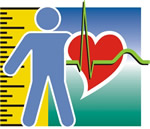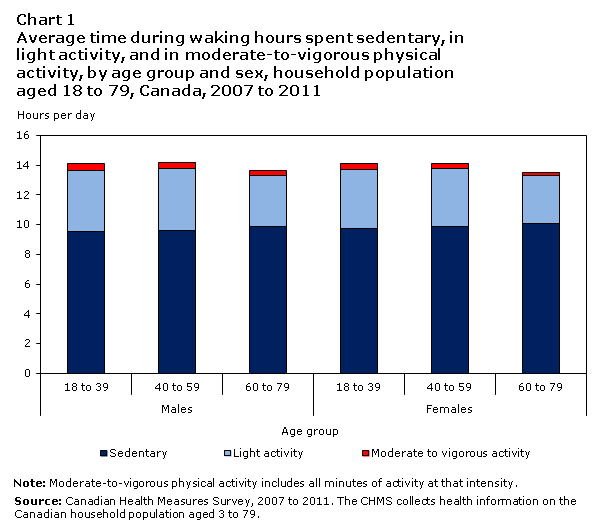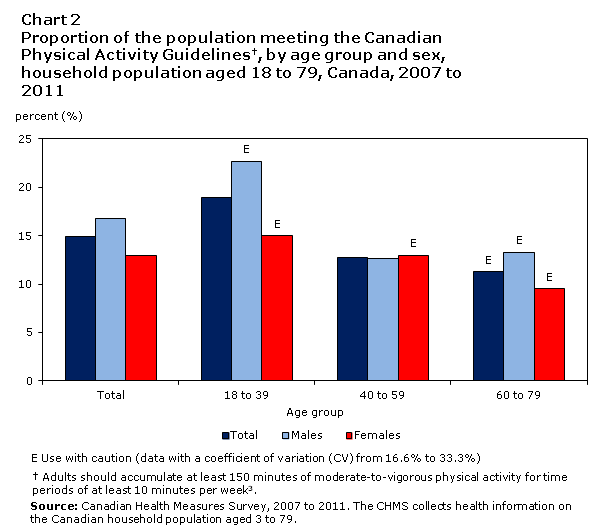Publications
Directly measured physical activity of Canadian adults, 2007 to 2011
Directly measured physical activity of Canadian adults, 2007 to 2011
Archived Content
Information identified as archived is provided for reference, research or recordkeeping purposes. It is not subject to the Government of Canada Web Standards and has not been altered or updated since it was archived. Please "contact us" to request a format other than those available.
 Regular participation in physical activity is recommended in adults for improving health. Physical activity is associated with a lower risk for various chronic conditions, including cardiovascular disease, some types of cancer, osteoporosis, diabetes, obesity, high blood pressure, depression, stress and anxiety.1 The risk for many of these conditions is reduced by 20 to 40% in adults with the highest levels of physical activity compared to adults with the lowest levels of physical activity.1
Regular participation in physical activity is recommended in adults for improving health. Physical activity is associated with a lower risk for various chronic conditions, including cardiovascular disease, some types of cancer, osteoporosis, diabetes, obesity, high blood pressure, depression, stress and anxiety.1 The risk for many of these conditions is reduced by 20 to 40% in adults with the highest levels of physical activity compared to adults with the lowest levels of physical activity.1
On the other hand, recent research has shown that physical inactivity or sedentary time is associated with higher risk for chronic conditions such as obesity, diabetes, and cancer independent of physical activity levels.2 This means that additional sedentary time can increase the risk for disease even if the physical activity guidelines are met.2
About physical activity
Moderate-to-vigorous physical activity (MVPA) is activity which causes a person to sweat and breathe harder or be out of breath (e.g.; brisk walking, bike riding, jogging, cross-country skiing).
Light physical activity includes activities such as light household cleaning, cooking and leisurely walking.
Inactive or sedentary time includes any time spent sitting or lying down (e.g.; watching television, office work, car travel).
The Canadian Physical Activity Guidelines recommend that to achieve health benefits adults 18 and over should get at least 150 minutes of MVPA per week, made up of time periods lasting at least 10 minutes.3
Adults are inactive for the majority of the day
Canadian adults aged 18 to 79 spend an average of nearly 10 waking hours per day sedentary (not including sleep). Sedentary time was significantly higher in females compared to males, particularly in the 40 to 59 year age group (Chart 1). Sedentary time also varied with age, ranging from 9 hours and 30 minutes in the youngest age group in males to 9 hours and 54 minutes in the oldest age group in males. In females, sedentary time ranged from 9 hours and 39 minutes in the youngest age group to 10 hours and 6 minutes in the oldest age group (Chart 1).

Time spent in MVPA was higher for males than for females across all age groups. For both males and females, younger adults (18 to 39 years) spent more time in MVPA compared to older adults (40 to 79 years) (Chart 1). Males aged 18 to 39 spent the most amount of time in MVPA (32 minutes per day) and females aged 60 to 79 spent the least amount of time in MVPA (11 minutes per day).
Few Canadian adults met the physical activity guidelines
About 15% of Canadian adults met the current guidelines for weekly MVPA (Chart 2). A larger proportion of males met the guidelines (17%) than females (13%). The proportion of adults who met the guidelines was larger in young adults aged 18 to 39 years (19%) compared to adults aged 40 to 59 years (13%) and 60 to 79 years (11%).

Overweight/obesity and chronic conditions associated with physical activity levels in adults
Overweight and obese4 adults spent less time in MVPA compared to their normal-weight4 counterparts. The average time per day spent in MVPA was:
- 16 minutes for obese adults,
- 21 minutes for overweight adults, and
- 27 minutes for normal-weight adults (data not shown).
Adults who self-reported being diagnosed with at least one chronic condition spent less time in MVPA (20 minutes) compared to those who did not report any chronic conditions (27 minutes).
Data source
Data are from the 2007 to 2011 Canadian Health Measures Survey (CHMS; cycles 1 and 2 combined). The CHMS collected data from a nationally representative sample of Canadians aged 6 to 79 years from collection sites across Canada. Basic demographic and health information was collected during a household interview, followed by a series of direct physical measurements taken at a mobile examination centre (MEC). Respondents at the MEC were provided with an activity monitor to wear for the week following their appointment. The activity monitor was worn on an elasticized belt over the right hip during all waking hours. Activity monitors measure the amount of movement a person makes in order to determine the time spent in sedentary, light, and MVPA.
Provincial, census metropolitan area (CMA) or health region information on self-reported physical activity can be found in CANSIM table 105-0501 from the Canadian Community Health Survey (CCHS).
References
- Warburton D. ER, Charlesworth S, Ivey A, Nettlefold L, Bredin SSD. 2010. ‘A systematic review of the evidence for Canada's Physical Activity Guidelines for Adults’. International Journal of Behavioral Nutrition and Physical Activity, vol. 7, no 39.
- Tremblay MS, Colley RC, Saunders TJ, Healy GN, Owen N. 2010. ‘Physiological and health implications of a sedentary lifestyle’. Applied Physiology, Nutrition, and Metabolism, vol. 35.
- Canadian Society for Exercise Physiology. 2011. Canadian Physical Activity Guidelines. Ottawa, ON, www.csep.ca/guidelines. Accessed March 1, 2012.
- Statistics Canada. ‘Body composition of Canadian adults, 2009 to 2011. Health Fact Sheet, no 82-625-X, http://www.statcan.gc.ca/pub/82-625-x/2012001/article/11708-eng.htm.
- Date modified:
